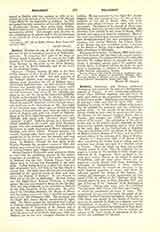

Ballerini, GIROLAMO and PIETRO, celebrated theologians and canonists, the sons of a distinguished surgeon of Verona. A rare intellectual sympathy bound these brothers together and led them to assist each other in the preparation and composition of their many works.
GIROLAMO was born at Verona January 29, 1702, and died April 23, 1781. After finishing his course in the Jesuit college of his native city he entered the seminary and was ordained a secular priest. In the pursuit of his favorite historical studies he soon came to appreciate the valuable labors of the learned Cardinal Noris, also of Verona, and brought out (1729-33) a complete edition of his works. The scholarship of the editors is best seen in the fourth volume, especially in their dissertations against Garnerius, and in their study of the early days of the Patriarchate of Aquileia. They also published (1733) an edition of the writings of Matteo Giberti Bishop of Verona, and in 1739 a critical edition of the sermons of St. Zeno of Verona.
PIETRO, b. September 7, 1698; d. March 28, 1769, after completing his studies both at college and the seminary was chosen principal of a classical school in Verona. Here he began his long and notable literary career in 1724, when he prepared for his pupils a treatise on the method of study taught and followed by St. Augustine. Some passages in this work gave serious offense to the school of absolute Probabilists, and for some years Pietro was engaged in a lively dispute with them, defending his principles of Probabiliorism in three volumes. Shortly afterwards he turned his attention to the much debated question of usury, and threw his influence against the claims of the Laxists. To sustain his argument in this controversy he prepared (1740) an edition of the “Summa” of St. Antoninus which he sent to Pope Benedict XIV, and also (1774) one of the “Summa” of St. Raymond of Pennafort. During this same year he published “La Dottrina della Chiesa Cattolica circa l’usura”, in which he condemned all forms of usury. This exceptional literary activity made the name of the Ballerini brothers famous throughout Italy, and in 1748 Peter was chosen by the senate of Venice to serve as its canonist in Rome in a dispute over the Patriarchate of Aquileia. His conspicuous talent on this mission attracted the attention of Pope Benedict XIV, who commissioned him to prepare an edition of St. Leo’s works in refutation of the defective one published by Quesnel.
After almost nine years of labor in which he enjoyed free access to all the libraries of Rome, Pietro brought out his monumental work in three volumes (Rome, 1753-57) reproducing the entire edition of Quesnel together with elaborate refutations and additions (Migne, P.L. LIV-LVI). The third volume is a profound study of the sources of canon law. Quesnel had published a collection of canons from a codex which he believed to have been in use under Popes Innocent I, Zozimus, and Leo the Great. Besides disproving this, Pietro brought out in an improved form earlier Latin editions of the canons, together with some very old unknown versions of Greek canons. He also published two valuable works (against Febronius) on papal power, “De vi ac ratione Primatus Romanorum Pontificum” (Verona, 1766), and “De potestate ecclesasticae Summorum Pontificum et Conciliorum generalium” (Verona, 1765).
LEO F. O’NEIL.

